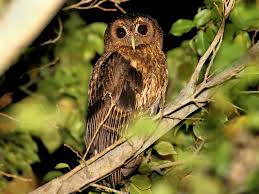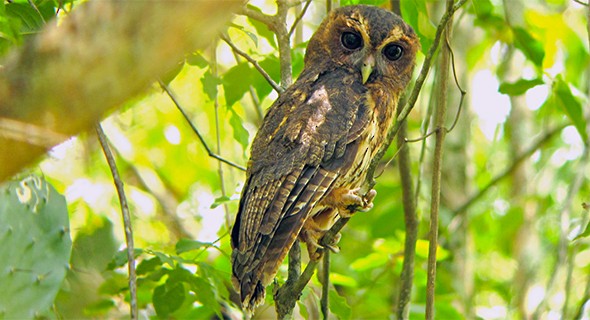Description
The brown owl or mottled owl, is a bird that measures between 35 and 41 cm long and weighs between 175 and 320 g. This
species of owl has a round head without earflaps. They have white eyebrows with black spots, the face outlined with a
white border and the top of the owl is usually dark brown. The lower parts are brown and with dark brown stripes. The tail
is long and also dark brown with many white bars. Spotted owls have a distinctive orange-yellow beak with brown eyes. In
general, there are two color phases of these owls; dark and clear. This species shows the highest degree of sexual
dimorphism of any species of owl; the females are larger and heavier than the males.
The reproductive season extends mainly between the months of February to April. For nesting, it uses natural cavities, located in
both trees and hollow trunks. Nesting has even been reported in abandoned nests of other bird species. This species is monogamous
and rarely interacts with other people besides its companions. The chickens are born asynchronically, and they open their eyes at
8 or 10 days of age. The juveniles begin to fly approximately at the month of born, between 27 to 33 days of age, but remain with
the parents for at least three more months.
The brown owl is a carnivorous bird that feeds on mammals, amphibians, reptiles and insects.
Habitat in humid tropical forests, gallery forests, deciduous forests, mountain forests, oak forests, cocoa plantations, forest
edges and near human habitation. This species has been recorded resting in the interior of the forest on trees at medium altitudes
with dense foliage and sometimes along streams.
The brown owl has a wide distribution in the Neotropics, from northern Mexico to western Ecuador, Bolivia and northern Argentina
and Paraguay, as well as in Trinidad and Tobago. In Mexico it is distributed on the Pacific slope from southern Sonora, southwest
of Chihuahua to the south, and on the slope of the Gulf of Mexico from southern Nuevo Leon and Tamaulipas to southern Chiapas and
east of the Yucatan Peninsula .






